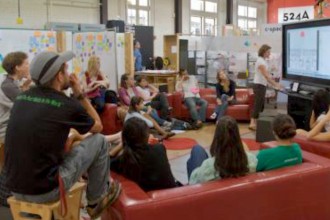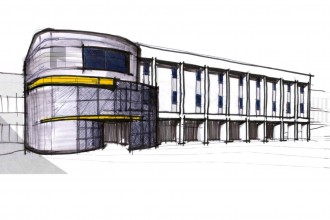 KALAMAZOO, Mich.—A Kalamazoo couple with a passion for the arts and a history of executive leadership in the community has given $3 million to support the creation of a new product design and innovation facility at Western Michigan University.
KALAMAZOO, Mich.—A Kalamazoo couple with a passion for the arts and a history of executive leadership in the community has given $3 million to support the creation of a new product design and innovation facility at Western Michigan University.
The gift from James and Lois Richmond will make possible the new interdisciplinary entity that will be named for them. The Richmond Product Design and Innovation Institute will combine the resources of WMU's colleges of Fine Arts and Engineering and Applied Sciences as well as the Haworth College of Business. Industry involvement includes some of the top names in southwest Michigan manufacturing.
The entity will house the new Bachelor of Fine Arts degree program in product design announced earlier this fall. It also will serve as a base around which key southwest Michigan corporate partners can focus their product design and development needs.
"WMU is uniquely positioned to prepare the next generation of product designers," says WMU President John M. Dunn. "Jim and Lois Richmond, through their generosity, have made an investment in this region's future by helping us create an innovative industrial design program that will combine form, function and manufacturing. This is the latest chapter in their long, thoughtful commitment to strengthening the ties that bind our campus and our community."
Kohrman Hall renovations

Conceptual rendering of WMU's Richmond Product Design and Innovation Institute
The Richmond gift will be used for renovations to 28,000 square feet on the first and third floors of Kohrman Hall. The renovations will include studios, presentation spaces and laboratories dedicated to innovation, fabrication, rapid prototyping, 3D printing, and woodworking and metalworking. Architectural work is already underway and the goal is to begin construction in spring 2017 and have the facility open in summer 2018.
"We're so pleased to see the way the University, community and local corporations are coming together to build a program that fully leverages Kalamazoo's strengths in the arts and innovation," says Jim Richmond. "This program will be a leader in the growing fields of design and innovation nationally, and will prepare WMU students for these important careers for generations to come."
Jim and Lois Richmond
Jim and Lois Richmond are both WMU graduates. Lois is a former assistant vice president of administration at Bronson Methodist Hospital. James was an executive with Stryker Corp., where he served as senior vice president of global marketing and development prior to his retirement in 1988. He has since served as a special consultant for Stryker, and came out of retirement briefly in 1995 to assist with reorganization of a major division in the company.
Jim Richmond is a well-known Kalamazoo area artist. His medium is scrap metal, found objects and wood gathered from unlikely places, such as factories and farm auctions. The Richmonds have a longtime association with the Kalamazoo Institute of Arts, where Jim has served on the board of directors and steering committee for the KIA school. Their commitment to the arts was celebrated nearly a decade ago with the naming of WMU's Richmond Center for Visual Arts, home to the Frostic School of Art. That facility was opened in March 2007.
Investment in success
College of Fine Arts Dean Daniel Guyette says the timing of the Richmond gift and industry support as well as the strengths of the Kalamazoo area will set the design and innovation program on a path to success.
"Kalamazoo possess ideal qualifications and an area market that will maximize the input of the industrial design community and allow us to connect our grads with world-class regional employers," says Guyette, who has been working on the initiative for the past three years.
Southwest Michigan companies already involved and in support of the effort include Whirlpool, Tekna, Newell Brands, Stryker, FabriKal, Landscape Forms and Eaton. Bob Brown and the Monroe-Brown Foundation provided key initial funding and area economic development agency Southwest Michigan First is actively involved as well.
"To create the perfectly modern three-legged stool that balances artist aesthetics, elegant engineering and a business-minded entrepreneurial spirit is challenging, but bringing these disciplines together into harmony to improve the interaction between humans and technology, is the ultimate goal." Guyette says.
For more WMU news, arts and events, visit wmich.edu/news.
